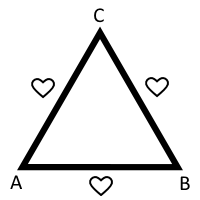What is polyamory?
Although it is repeatedly mentioned as such, polyamory is not an alternative sexuality, but an alternative model of romantic relationships. People are described as polyamorous, or (abbreviated) poly.
The word is a combination of poly which means “more than one, many” in Ancient Greek and amor which is Latin for “love”. It describes people who (want to) live in a romantic relationship with more than one person at the same time while every partner knows of all other partners and every relationship is consensual for all connected individuals.
From the outset, a polyamorous lifestyle requires more time, energy and emotional labour than a closed romantic relationship between two individuals, simply because more than two people have to agree on things on a daily basis. In addition, in multiple relationships, questions and problems arise that cannot happen between two individuals, like, “Who sleeps in the middle?” or “Could you mediate between us?”.
Since our existing language does not include representations of polyamory, new terms are needed to describe these relationships. The idea of the heteronormative mainstream, the majority culture, is that a romantic relationship consists of two people. This is reflected in the language: A romantic couple always means two people, but a couple of friends can be any number of people.
Polyamory, however, needs more than one romantic relationship, that is, at least three people. Thus, individuals in a network of romantic relationships were compared to connected atoms, and termed a polycule, as a portmanteau of polyamory and molecule.
As soon as more than two people are connected over the romantic level, complexity increases by a certain factor, with every additional individual. The comparison to a molecule is therefore appropriate even beyond wordplay: In chemistry, over time, everything falls back to the next stable level that needs the least amount of energy. Networks of people tend to do the same, and as a result, the most common long-term stable polycules consist of the minimum amount of people, that is, three individuals. A polycule of three individuals may occur in two different forms which are named after their visible structure.
In the figures below, the letters stand for the individuals involved, and the lines with heart show a romantic relationship.

A triad or poly triad is a triangle formed out of the romantic relationships A+B, B+C, and A+C.
A further term is throuple, a portmanteau of three and couple, because, well, there are three couples.

A V includes two romantic relationships A+B, and B+C, but not A+C. The term metamour was invented for the relationship between person A and person C, from meta which is Latin for “over something” and amour which is French for “a lover”. So metamours share a meta-love, over person B who connects them. The actual intimacy between metamours is not defined, except for the absence of a romantic relationship, and differs in individual cases: Some are best friends, while others barely know each other.
A polycule of four people is called a square, where not all the connections of the square must be romantic relationships, but may also contain metamours. Its most common variant is the N, which contains three relationships in a row, and three metamours:

For other constellations, I am not aware of any special terms other than polycule. However, since many people who are interested in polyamory have an academic background, they have established the convention to describe polycules in scientific notation with an angular letter in the Latin or Greek alphabet.
I, the author of this blog, am biromantic and I live a polyamorous lifestyle: I have a girlfriend and a boyfriend who are a couple as well. Together we form a romantically closed triad (= We are three people, and we all do not pursue any further romantic interests).
Apart from these definitions, there is not “the one way” of living polyamory, which does not mean that all polyamorous lifestyles work, that is, produce loving, stable, long-term romantic relationships. Some strategies never even produce more than parallel short-term relationships.
Recent definitions of polyamory take this consequence into account, for example, the Austrian polyamory researcher Stefan Ossmann defines more precisely:
Polyamory is a consensual relationship between more than two people based on emotional love and intimate acts over a longer period of time.
Ossmann, Stefan. F. (2020). Introducing the new kind on the block: Polyamory. In Z. Davy, A. C. Santos, C. Bertone, R. Thoreson, S. Wieringa (Eds.), Handbook of Global Sexualities (Vol. 1, pp. 363-385).
